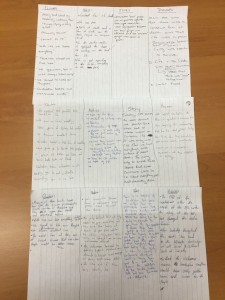I have been exploring some of the writing-based pedagogical strategies advocated by the Institute for Writing and Thinking at Bard College in New York.
Free-writing is a technique where students and the teacher (this is important), write for a set period, usually around five minutes. A period of private free-writing, where you write about whatever comes to mind, clears the mind for more focused thinking.
Here are some of the guidelines for free-writing:
- Write as fast as you can, without thinking.
- If your flow stops, leave a space and immediately begin again
- Write for the full 5 minutes
- Write past the point where you feel you have nothing to say
- Find something interesting to explore
- No mistakes are possible; the only mistake you can make is not to write
- Keep your hand moving
- Don’t worry about spelling, punctuation, or grammar
- Lists are OK
- Think of it as play
- Messy is good
- Sentences are overrated
A focused free-write can then follow with students responding to a specific prompt (perhaps subject-based). Once finished they can share publicly aloud in the classroom. It is this sharing of the work that starts to signal to students. They begin to think more deeply about their own writing, language, and how to develop.
When students publicly share their work by reading aloud, a useful teaching technique is “pointing”. This involves having other students write down anything that really resonates with them as their peers are sharing, and then collaboratively sharing these ideas, best described as “verbal jazz”.
I’m also interested in the concept of process writing, when students respond to prompts like, “What do I notice about myself as a writer?” or “I am the writer who…”

Further writing to learn techniques, including loop writing, collaborative learning questions, and dialectical notebooks (examples above) are described in Writing-Based Teaching by Teresa Vilardi and Mary Chang. I now use free-writing at the start of most lessons and a number of other techniques which enable me to use writing to help my students learn.
Hi Cam
I’ve been using free writing for a while now and it does help free up the students’ brains and their thinking. My advice to them when the ‘flow’ stops is to continue re-writing the last word until a new idea pops up in their head. Great for stream-of-consciousness writing as well.
Love this idea! Free-writing is a great technique that will engage students in frequent writing tasks. This is also a great tool when preparing for a standardized test, mainly because the students are timed and they must brainstorm quick enough to complete their writing portion.
Hello Cameron!
Free writing does really help students get started. I remember my middle school english teacher would always tell us to write out all of our thoughts so that we wouldn’t lose any of our best ideas for the paper. Its funny I still use some of these tips to this day.